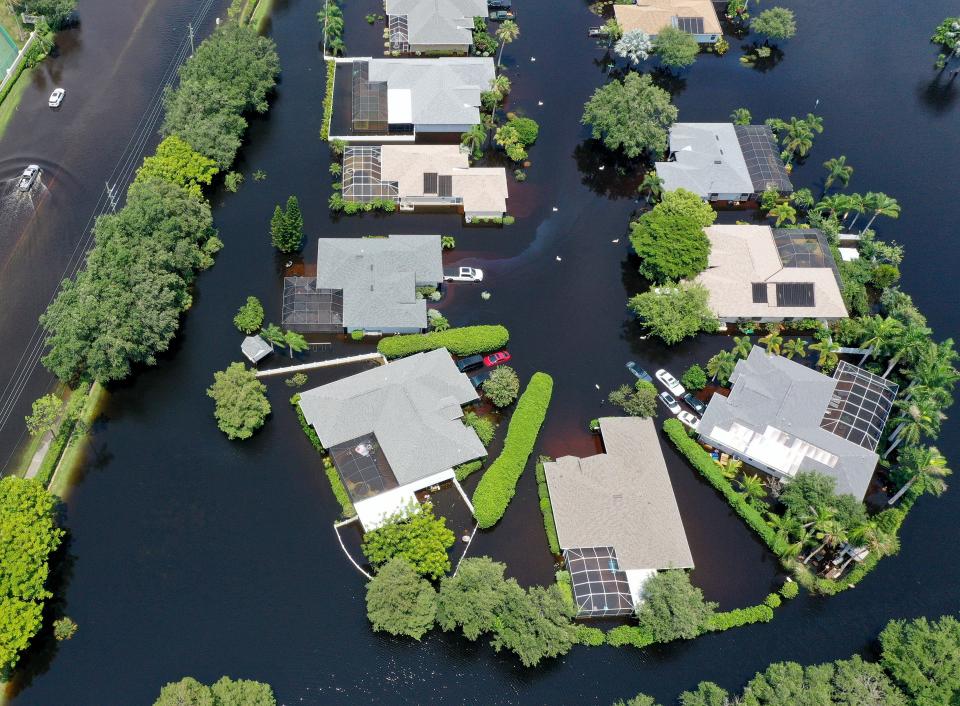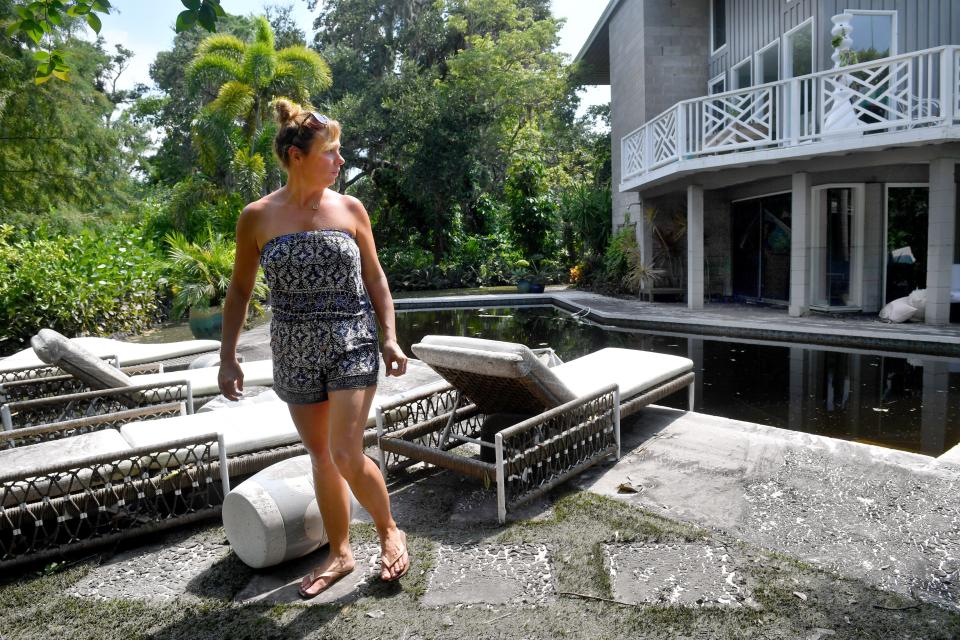At least some 33 St. Johns County neighborhoods experience severe flooding. That's what happens when corporations and politicians untethered to truth pass unjust laws to fill in swamps and obtain development orders, without fair hearings and full investigation, after secretive ex parte meetings with developers. From Sarasota Herald-Tribune:
As flood waters swallow neighborhoods, frustrated Sarasota residents blame development
Flood waters along Phillippi Creek were not all that spilled over as a tropical system pounded the region with historic rains.
Frustration and outrage accompanied posts with devastating photos of flooded neighborhoods on social media in the days that followed Debby's deluge.
Post after post on Facebook blamed "overdevelopment" and the local officials who "allowed" it to happen.
One post on Reddit titled "Sarasota County officials have ruined this county and we are going to pay the price" went viral. Most online commenters agreed with the author's sentiment.
Even state Sen. Joe Gruters, a pro-growth Republican, called for financial assistance and a state investigation in a letter to Gov. Ron DeSantis after developments built under updated building codes suffered catastrophic flooding.
"I don't know why this has happened, but I know it has, and it should not have," he wrote to DeSantis.
As residents point fingers, real estate professionals deny that development has exacerbated the issues. Government officials have deflected questions.
Cole Washko, a public information officer with Sarasota County, said the county's Public Works and Development Services departments "conduct an in-depth stormwater study of large-scale development during the rezone and permitting processes."
"Planned development must demonstrate it (development) will not adversely affect the watershed in which it is located," he said in an email.
For Sarasota, a 100-year event equals 10 inches of rain in 24 hours.
Washko said that level of regulation is the "most stringent stormwater regulation for development."
Some areas of eastern Sarasota and southern Manatee counties saw as much as 18 to 19 inches of rain, according to some projections from the National Weather Service.
He noted that Sarasota County residents receive a 20% reduction in flood insurance premiums due to the level of regulation the county has in place. The county recently qualified for an even greater reduction in premiums after qualifying for a "Class 2 rating," which will allow residents to receive a 40% reduction in premiums in later years.
Hurricane Debby rainfall was historic
Three of the top 10 three-day rainfall totals occurred as Debby dumped rain over the area. That's not including several hours Monday morning as the National Weather Service collection device at the Sarasota Bradenton International Airport lost power during part of the storm early on Aug. 5.
The National Weather Service recorded a record 11.06 inches of rain on Aug. 4 at a collection device at the Sarasota Bradenton International Airport, breaking the old one set during World War II.
The National Weather Service's records start in 1911.
Four of the top seven heaviest single-day rainfalls have occurred since 2001.
Frustration mounts among residents
Allison Werner bought her house in the South Gate neighborhood in 2013 on a tributary to Phillippi Creek along North Seclusion Drive. While she knew her property was in a flood zone, the trickle of water behind her home often can be mistaken for a "mudpuddle," she said.
As the water rose, she brought her chickens out of their coop and into the home fearing they would be swept away. Then she went to sleep.
The next day, she discovered flood waters up to her doorknobs had inundated the first level of her three-story house.
More Debby coverage: Heavy flooding and sewage spills. How bad was Debby's impact on Sarasota-Bradenton water?
ICYMI: How much damage did Hurricane Debby leave in Manatee County? Officials give early estimate
"There was so much water," she said. "Nothing like this has ever happened to me before. I was in shock."
As feet of water covered her property, neighbors kayaked down the street.
"It was so surreal," she said. "This happens on the news. This doesn't happen in my life. This is my house that is underwater."
Stuck in a flooded house, Werner said she didn't realize most of Sarasota County did not experience the same level of devastation.
"I didn't know just one street away, life was going on as if nothing had happened," she said.
Tuesday night she was able to wade out of her home, the street still flooded.
"There have been storms that were way scarier, way worse and this has never happened," she said. "This could not have possibly been just rain."
The culprit in her mind was residential development around the Celery Fields.
"I believe that the new construction around the Celery Fields is putting an impossible burden on the creek for drainage and that my neighborhood and others along the path of the creek are paying the price," she wrote to county commissioners.
Like Gruters, she also called for an investigation into the causes of the flooding.
Celery Fields and flooding
A few years after a storm flooded hundreds of homes in Sarasota County in 1992, county officials purchased about 300 acres of property locally known as The Celery Fields and invested about $27 million to improve drainage of the Phillippi Creek Drainage Basin.
The Celery Fields, according to a management plan prepared by a consultant for Sarasota County in 2016, drains more than 3,500 acres in the 55-square-mile basin.
The project has been widely considered a success story, with the community seeing an almost immediate impact from the investment, according to a case study conducted by the Federal Emergency Management Agency.
"After three years of construction on the first two phases of the project, the test came in November and December 1997 when two 100-year events (a level of flooding that has a 1% chance of occurring in any given year) deluged the flood-prone area," according to the FEMA case study. "The design worked. Nearby homes were spared from flooding."
In recent years, Sarasota County has undergone rapid development as shopping centers and new housing replaces agricultural or vacant land.
Tom Matrullo, a community activist involved with the Sarasota Citizen Action Network, criticized decisions the county commission has made in recent years like moving the Urban Service boundary, increasing density east of Interstate 75 and allowing developers to have their way on most issues.
"The way this county handles issues — it tends to operate to the will of the developers," he said. "They aren't thinking about the quality of life of their current resident. They think about what the developer wants."
Martullo also questioned the flow of information to the public after the storm, indicating he felt county officials "ghosted" the residents.
Pushing the problem into neighborhoods?
Bill Conerly, a professional engineer with Kimley-Horn, spoke at length about the development review process and how he designs stormwater management systems.
Conerly has 27 years of experience as a professional engineer focused on stormwater.
He said Sarasota County has extensive modeling of the entire county that requires development projects to not adversely impact surrounding areas. The reports are routinely hundreds of pages.
"You can't push your problem onto your neighbors," he said. "You have to account for everything."
Conerly once spent about six months attempting to design stormwater management for a particularly tricky site. However, two miles away the model's tables showed an increase in water of slightly less than half an inch, too much to pass regulation.
What really happened during the storm, Conerly said, was that design capacities were exceeded because of historic rains.
"The systems broke down because they were not designed for the intensity of the rain," he said.
Answer lies somewhere in the middle
Daivd Kaplan, director of the H.T. Odum Center for Wetlands at the University of Florida, could not give a definitive response to whether development causes flooding.
"It depends," he said.
Kaplan said newer development codes "attempt to mimic the natural" way water flows in the environment before development.
"It's a quantitative approach to design for a specific storm," he said. "You build models to understand the hydrology of a site used to look like and then what it will look like after development."
The stormwater features and other systems attempt to mitigate the buildings and pavement resulting from new development.
"No doubt there is tremendous improvement in how land development has occurred since the Clean Water Act was approved," he said.
"But a model is only as good as a model," he said. "And the ability to predict the changes at a half-inch or less are somewhat limited."
Kaplan said that models are a representation of reality, and an excellent tool, but "the devil's in the details."
He said many other factors would go into determining whether a particular development or cumulative development contributed to the increased flooding the region experienced. Those could include fragmenting flood plains or drainage patterns, which can have a large effect not captured in current models.
Even compacting the soil during construction can impact the ability to absorb flood water.
"All of these can contribute to flooding of a local area," he said. "And they can have cumulative impacts."
Still, Kaplan was hesitant to say that development significantly contributed to the flooding.
"It's obvious to everyone that the increase in roads and impervious surfaces, and properly sizing these stormwater features, is a challenge," he said.
"We are seeing this local effect of climate change. Warmer waters, warmer atmosphere leading to larger rainfall events. This is probably not news for the people who follow the predictive effects of climate change and cities and municipalities are trying to adjust in large part to how they do their planning to account for these new and more frequent larger storms, but there's some lag time there in updating the regulations."
This article originally appeared on Sarasota Herald-Tribune: Sarasota residents frustrated after Debby's floods blame "development"



No comments:
Post a Comment